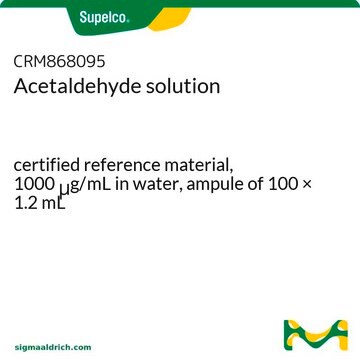00070
Acetaldeide
puriss. p.a., anhydrous, ≥99.5% (GC)
Sinonimo/i:
Etanale
About This Item
Prodotti consigliati
Origine biologica
synthetic
Livello qualitativo
Grado
anhydrous
puriss. p.a.
Densità del vapore
1.52 (vs air)
Tensione di vapore
14.63 psi ( 20 °C)
Saggio
≥99.5% (GC)
Forma fisica
liquid
Temp. autoaccensione
365 °F
Qualità
anhydrous
Limite di esplosione
60 %
Impurezze
≤0.5% free acid (as CH3COOH)
Residuo dopo evaporazione
≤0.002%
Indice di rifrazione
n20/D 1.332 (lit.)
n20/D 1.332
P. eboll.
21 °C (lit.)
Punto di fusione
−125 °C (lit.)
Densità
0.785 g/mL at 25 °C (lit.)
Cationi in tracce
Al: ≤0.5 mg/kg
Ba: ≤0.1 mg/kg
Bi: ≤0.1 mg/kg
Ca: ≤0.5 mg/kg
Cd: ≤0.05 mg/kg
Co: ≤0.02 mg/kg
Cr: ≤0.02 mg/kg
Cu: ≤0.02 mg/kg
Fe: ≤0.5 mg/kg
K: ≤0.5 mg/kg
Li: ≤0.1 mg/kg
Mg: ≤0.1 mg/kg
Mn: ≤0.02 mg/kg
Mo: ≤0.1 mg/kg
Na: ≤0.5 mg/kg
Ni: ≤0.02 mg/kg
Pb: ≤0.1 mg/kg
Sr: ≤0.1 mg/kg
Zn: ≤0.1 mg/kg
Temperatura di conservazione
2-8°C
Stringa SMILE
CC=O
InChI
1S/C2H4O/c1-2-3/h2H,1H3
IKHGUXGNUITLKF-UHFFFAOYSA-N
Cerchi prodotti simili? Visita Guida al confronto tra prodotti
Categorie correlate
Descrizione generale
Applicazioni
Avvertenza
Avvertenze
Danger
Indicazioni di pericolo
Consigli di prudenza
Classi di pericolo
Carc. 1B - Eye Irrit. 2 - Flam. Liq. 1 - Muta. 2 - STOT SE 3
Organi bersaglio
Respiratory system
Codice della classe di stoccaggio
3 - Flammable liquids
Classe di pericolosità dell'acqua (WGK)
WGK 3
Punto d’infiammabilità (°F)
-38.0 °F - closed cup
Punto d’infiammabilità (°C)
-38.89 °C - closed cup
Dispositivi di protezione individuale
Eyeshields, Faceshields, Gloves
Scegli una delle versioni più recenti:
Possiedi già questo prodotto?
I documenti relativi ai prodotti acquistati recentemente sono disponibili nell’Archivio dei documenti.
I clienti hanno visto anche
Protocolli
-Tolualdehyde; Valeraldehyde; Isovaleraldehyde
Separation of Acetone; Acetic acid; Propionic acid; Ethyl butyrate; Ethanol; Isoamyl acetate; Isobutyric acid; 3-Methyl-2-butanol; Methyl acetate; 1-Propanol; Acetal, ≥98%, FG; 2-Methyl-1-pentanol; Butyl acetate; Ethyl propionate; 3-Pentanol; 2-Pentanol, 98%; Ethyl isobutyrate; Isobutyl acetate; Acetaldehyde; Furfural; Butyric acid; Methanol; Ethyl acetate
Il team dei nostri ricercatori vanta grande esperienza in tutte le aree della ricerca quali Life Science, scienza dei materiali, sintesi chimica, cromatografia, discipline analitiche, ecc..
Contatta l'Assistenza Tecnica.






